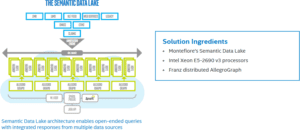Montefiore Patient-centered Analytical Learning Machine “PALM” Solution Brief

Addressing value-based healthcare with Intel® Xeon® processors and Franz’s AllegroGraph
Challenge
Like all healthcare organizations, Montefiore faces complex challenges from government pressures to reduce costs and stringent regulatory guidelines to diverse patient populations and disruptive technologies. A focus and investment in precision medicine has brought the nation’s and industry’s attention to expanding the breadth of patient data in order to personalize treatment for individuals and historically underrepresented groups. Further, understanding patients requires information on a complex array of factors, some of which may not even be known during a clinical interaction, such as the home and work environment, nutrition, and genetics.
Solution
To optimize healthcare based on advanced data analytics and make sure clinicians have the right information available in time to impact patient outcomes, Montefiore has deployed the Patient-centered Analytical Learning Machine – (“PALM”), formerly known as the Semantic Data Lake*, a solution that brings together varied and vast amounts of raw data for deeper analysis to flag patients who are at risk or help clinicians identify optimal treatment plans. Drawing on extensive experience in patient care and medical research, this innovative solution enables relevant data to directly inform and impact patient care.
The platform integrates both structured and unstructured data ranging from basic science, clinician records, and population demographics to community, environmental, behavioral, and wellness research data. By assessing a holistic and realistic profile of patients—along with relevant science, clinical population histories, drug information, and medical imaging— PALM has the capability to improve care, identify at-risk patients, and personalize medicine, while reducing error and inefficiency.
Technical Details
PALM is built on Intel® architecture and Franz’s AllegroGraph, a high-performance semantic graph database enabling analytics based on industry standards. PALM includes data from Montefiore’s own institutions, as well as from sources such as the PharmGKB databank (which correlates genetic variations and drug responses), the National Institute of Health’s Unified Medical Language System (UMLS), and the Online Mendelian Inheritance in Man, a continuously updated catalog of the human genome and genetic disorders.
<!-- Semantic Data Lake automatically injects metadata into the data layer to create ties between different components of the data. This makes the data “discoverable” via an innovative interrogation mechanism. On top of the basic data framework, Montefiore injects knowledge bases and ontologies—basically the semantics that characterize the data and gives it meaning and a specific context. The solution provides a breadth of data management technologies including:
- Incorporation of a semantic data lake in which myriad information types such as billing codes, patient events, medical procedures, and more are centralized and codified using semantic relations, industry standards, and domain-specific knowledge bases.
- Deployment of predictive analytics at a scale to leverage this data to anticipate and account for various patient outcomes in timeframes in which treatment can be administered to affect care.
- Use of machine learning algorithms to integrate the results of previous outcomes that significantly impact the analysis and effects of future patient objectives.
- Incorporation of an ontological pipeline that rapidly integrates new data sources (e.g., wearables, home sensing technology, and IoT) and requirements into existing models, and validates the clinical process for highly targeted patient subsets.
- Inclusion of disposable data marts akin to sandboxes that quickly provision analysis-ready, project-specific environments in which data scientists can manipulate data and analytics results, while simultaneously allowing others to leverage that same data for their own purposes without duplication of data or redundant pipelines.
|
“AllegroGraph allows Montefiore to extract sophisticated decision insights and predictive analytics from highly complex, distributed data in a way that is not possible using conventional databases.” |

<!--
Impact</h3
For its first pilot of the Semantic Data Lake, Montefiore and Einstein chose to address a pressing issue for accountable care: identifying high-risk patients in need of critical, time-sensitive intervention. Says Dr. Mirhaji, “We wanted to use predictive analytics to flag any patient hospitalized at Montefiore Health System locations who is at risk of death or in need of intubation within the following 48 hours, which is the window of opportunity to complete an effective intervention.”
The combination of automated predictive and preventive approaches has proven effective in identifying patients at highest risk, and providing consistent clinical decision support to relevant practitioners, just in time and throughout the entire Health System. Accurate prediction of prolonged ventilation detects patients with more than 70% likelihood of an event, 48 hours in advance of a fatal episode or respiratory failure in the hospital.
Montefiore and Einstein drew on historical data from its own patient population and that of the Mayo Clinic to define a predictive algorithm that would generate a score identifying the level of patient risk. The system also helps advise clinicians on the most effective next steps. Explains Dr. Mirhaji, “It creates risk scores based on the patient’s likelihood of a major event. Then there’s another engine that kicks in based on those risk scores and other factors to determine what we can do for that particular patient to avoid the crisis. It can send a personalized checklist of proposed interventions to the practitioner in charge of that case.
Intubation identification is being used successfully at Montefiore, but it represents only one of nearly unlimited possibilities Semantic Data Lake offers for improving patient care and revolutionizing care models and medical research.
Racine summarizes the impact: “Semantic Data Lake gives us the ability to search the information that’s available to us in a much more efficient way in order to find patterns in the data and to use those patterns for clinical purposes. This is now being instituted throughout our critical care systems in all of the hospitals within the medical center.”
Discover More about Montefiore
Watch the video to discover more about how Montefiore/Einstein has approached the challenge of turning its data into high-value insight through advanced analytics.
-->
Read the Full Brief produced by Intel and Visit Intel’s Healthcare Website.
Watch an interview – The Atlantic Live.